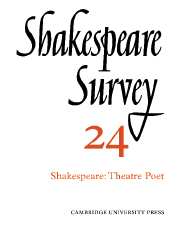Book contents
- Frontmatter
- Hearing Shakespeare: Sound and Meaning in ‘Antony and Cleopatra’
- ‘More Pregnantly Than Words’: Some Uses and Limitations of Visual Symbolism
- Shakespeare and the Limits of Language
- Revenge, Retribution, and Reconciliation
- Shakespeare the Professional
- Shakespeare’s Talking Animals
- The Morality of ‘Love’s Labour’s Lost’
- Shakespeare’s ‘Earth-treading Stars’: the Image of the Masque in ‘Romeo and Juliet’
- ‘Hamlet’ and the ‘Sparing Discoverie’
- ‘Hamlet’ in France 200 Years Ago
- The Hamlet in Henry Adams
- ‘Pericles’ and the Dream of Immortality
- A Necessary Theatre: The Royal Shakespeare Season 1970 Reviewed
- Free Shakespeare
- The Year's Contributions to Shakespearian Study 1 Critical Studies
- 2 Shakespeare’s Life, Times, and Stage
- 3 Textual Studies
- Index
- Plate section
‘Hamlet’ and the ‘Sparing Discoverie’
Published online by Cambridge University Press: 28 March 2007
- Frontmatter
- Hearing Shakespeare: Sound and Meaning in ‘Antony and Cleopatra’
- ‘More Pregnantly Than Words’: Some Uses and Limitations of Visual Symbolism
- Shakespeare and the Limits of Language
- Revenge, Retribution, and Reconciliation
- Shakespeare the Professional
- Shakespeare’s Talking Animals
- The Morality of ‘Love’s Labour’s Lost’
- Shakespeare’s ‘Earth-treading Stars’: the Image of the Masque in ‘Romeo and Juliet’
- ‘Hamlet’ and the ‘Sparing Discoverie’
- ‘Hamlet’ in France 200 Years Ago
- The Hamlet in Henry Adams
- ‘Pericles’ and the Dream of Immortality
- A Necessary Theatre: The Royal Shakespeare Season 1970 Reviewed
- Free Shakespeare
- The Year's Contributions to Shakespearian Study 1 Critical Studies
- 2 Shakespeare’s Life, Times, and Stage
- 3 Textual Studies
- Index
- Plate section
Summary
In writing Hamlet Shakespeare, with his usual versatility, seems to have used several sources of various kinds. Not only did he draw on a previous version of the story but he also found material for his purposes in such works as Lyly’s Euphues, Bright’s Treatise of Melancholie, and Nashe’s Pierce Pennilesse. Another work which offers considerable evidence that it may belong to this list is a little-known pamphlet published in London in 1601, one of the several polemics which emanated from the current disputes within the English Catholic priesthood known as the Archpriest Controversy. Admittedly this is not the kind of work which Shakespeare, so far as we know, was in the habit of utilizing. Among his recognized sources the only one that even remotely resembles it, indeed the only example of a religious polemic, is Samuel Harsnet’s violently anti-Catholic A Declaration of Egregious Popish Impostures. Yet the pamphlet shows so many verbal and other resemblances to Hamlet that it raises the question whether it might have a connection with the play.
- Type
- Chapter
- Information
- Shakespeare Survey , pp. 71 - 78Publisher: Cambridge University PressPrint publication year: 1971

